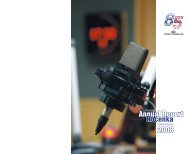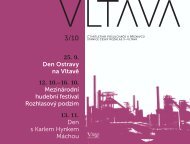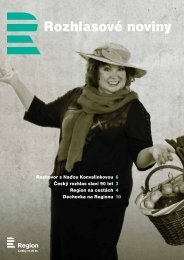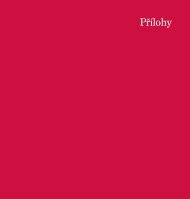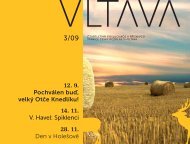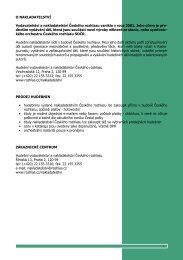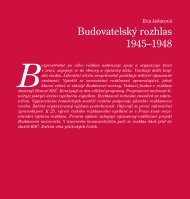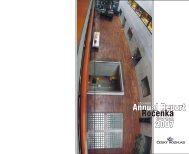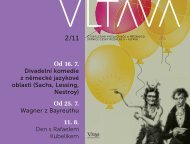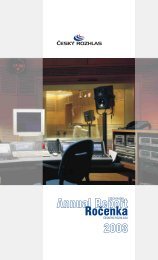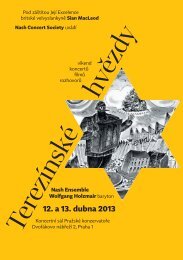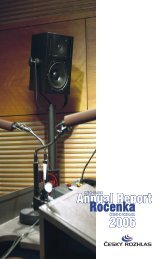Rozhlasový podzim - Český rozhlas
Rozhlasový podzim - Český rozhlas
Rozhlasový podzim - Český rozhlas
You also want an ePaper? Increase the reach of your titles
YUMPU automatically turns print PDFs into web optimized ePapers that Google loves.
15| 10| Pá 19.00| Sál Martinů | Pražské premiéry<br />
15| 10| Fri 7.00 pm| Martinů Hall | Prague premieres<br />
Bernardas Brazdžionis, who emigrated to the USA after WW II. In this poem, which inspired the creation of<br />
the composition, there is room for fantasy, dreaming of Beauty, and the perpetual conflict with reality... This<br />
seems to be the theme of most of my work. “Illusion“ reflects the never ending human attempt to achieve<br />
something unattainable, see the invisible, and hear the inaudible... The composition consists of one movement.<br />
It is a dialogue of man with the surrounding world, and this dialogue dramaturgically determines the<br />
conflict in the work. I did not think about any particular techniques, I wanted each instrument to “speak” with<br />
its typical voice.<br />
In the structure of this composition an experienced listener will hear hidden series of unrepeated tones and<br />
their modifications, clusters, and harmonies permeating the whole piece, supported by the sound of an open<br />
guitar string. However... This is only the composer’s “cuisine“... It is the result and the emotional level of the<br />
music that is important to the listener – the things that bring or do not bring excitement, are worth thinking<br />
about and being experienced with the musicians or worth being thrown away... The composition is dedicated<br />
to the initiators of its creation – the guitarist Reinbert Evers, conductor Donatas Katkus, and the Lithuanian Saint<br />
Christopher Chamber Orchestra.<br />
Anatolijus Šenderovas<br />
www.mic.lt/en/persons/info/senderovas<br />
Arvo Pärt (born on 1935) is a composer of international stature whose music is characterized by strong<br />
compositional logic and sacral atmosphere. As the boldest innovator of 1960s Estonian music, he brought<br />
into play all the most important modernist techniques of composition in his earlier works. In 1980s, Pärt<br />
achieved worldwide renown by his meditative tintinnabuli style. Arvo Pärt‘s music has a remarkable influence<br />
on Estonian contemporary music. Arvo Pärt studied music theory at the Tallinn Music High School<br />
in 1954–1957 and continued with studies of composition at the Tallinn Conservatoire in 1957–1963 as<br />
a student of Heino Eller. From 1958 to 1967, he worked as a sound director at Estonian Radio, thereafter he<br />
became a freelance composer. In 1980, Pärt and his family emigrated from Soviet Estonia for political reasons<br />
to Vienna and one year later, travelled on a DAAD scholarship (German Academic Exchange Service) to Berlin.<br />
After the restoration of Estonian Republic in 1991, Pärt’s ties with his homeland were restored. Arvo Pärt’s<br />
first works written for the piano – 2 sonatinas (1958–1959), Partita (1959) and others – represent neoclassicist<br />
style. In his 1960s work, sonorism became dominating. Pärt‘s first orchestral work was Nekrolog (1960) for<br />
symphony orchestra – the first dodecaphonic work in Estonian and Soviet music. Written in ground of sonoristic<br />
and serial methods, his Symphony No. 1 (Polyphonic, 1963) and orchestral work Perpetuum mobile<br />
(1963) dedicated to Luigi Nono stand out as vivid examples of Pärt‘s „architectonic“ form shaping. From<br />
1965, after the performance of the Perpetuum mobile at the Warsaw Autumn Festival, Pärt‘s music became<br />
known internationally. Pärt‘s Collage on BACH (1964) for oboe and orchestra, the cello concerto Pro et contra<br />
(1966), Symphony No. 2 (1966) and Credo (1968) for piano, mixed choir and orchestra, on the Jesus‘ Sermon<br />
on the Mount, are based on the collage technique contrasting dramatic sound patterns with luminous tonal<br />
harmonic citations or stylisations. After the three-year break and studying old manuscripts of sacral music,<br />
Pärt completed his Symphony No. 3 – the landmark of his new style inspired by medieval vocal music. From<br />
1976, the peaceful and euphonic tintinnabuli style (tintinnabuli – „bell“ in Latin), inspired by Gregorian chant<br />
and Netherlands‘ vocal polyphony, became the basis of Pärt’s music. The new style interweaves a „melodic<br />
voice“ moving stepwise and the triadic tintinnabuli voice. Its special features are meditative time flow and<br />
“breathing” phrases. The first work in the tintinnabuli style was the piano piece For Aliina from 1976. Following<br />
in 1977 Tabula rasa – a concerto for two violins, a piano and strings, Cantus in memory of Benjamin Britten for<br />
strings and bell and Fratres having a large number of different instrumentations, are popular up to now. From<br />
1980s, Pärt has written many works for choir and/or vocal soloist(s) with or without accompaniment, based<br />
on religious texts, including Passio (1982), De profundis (1980), Te Deum (1985/1992), Magnificat (1989),<br />
Miserere (1989/1992), Berliner Messe (1990/2002), Litany (1994/1996), Kanon pokajanen (1996), Como cier-<br />
44



